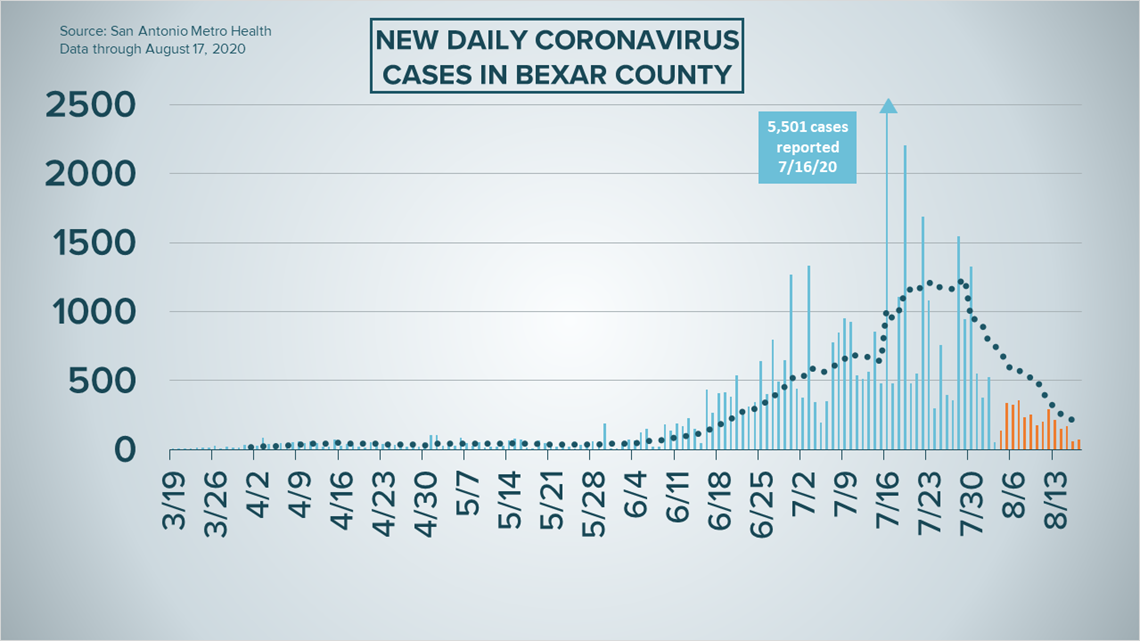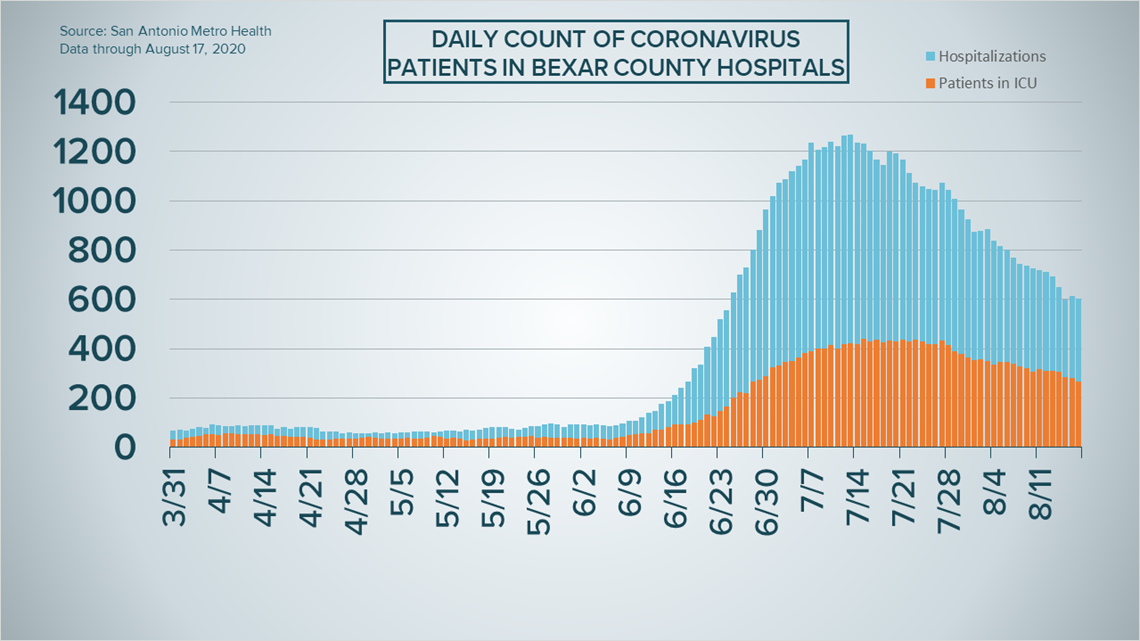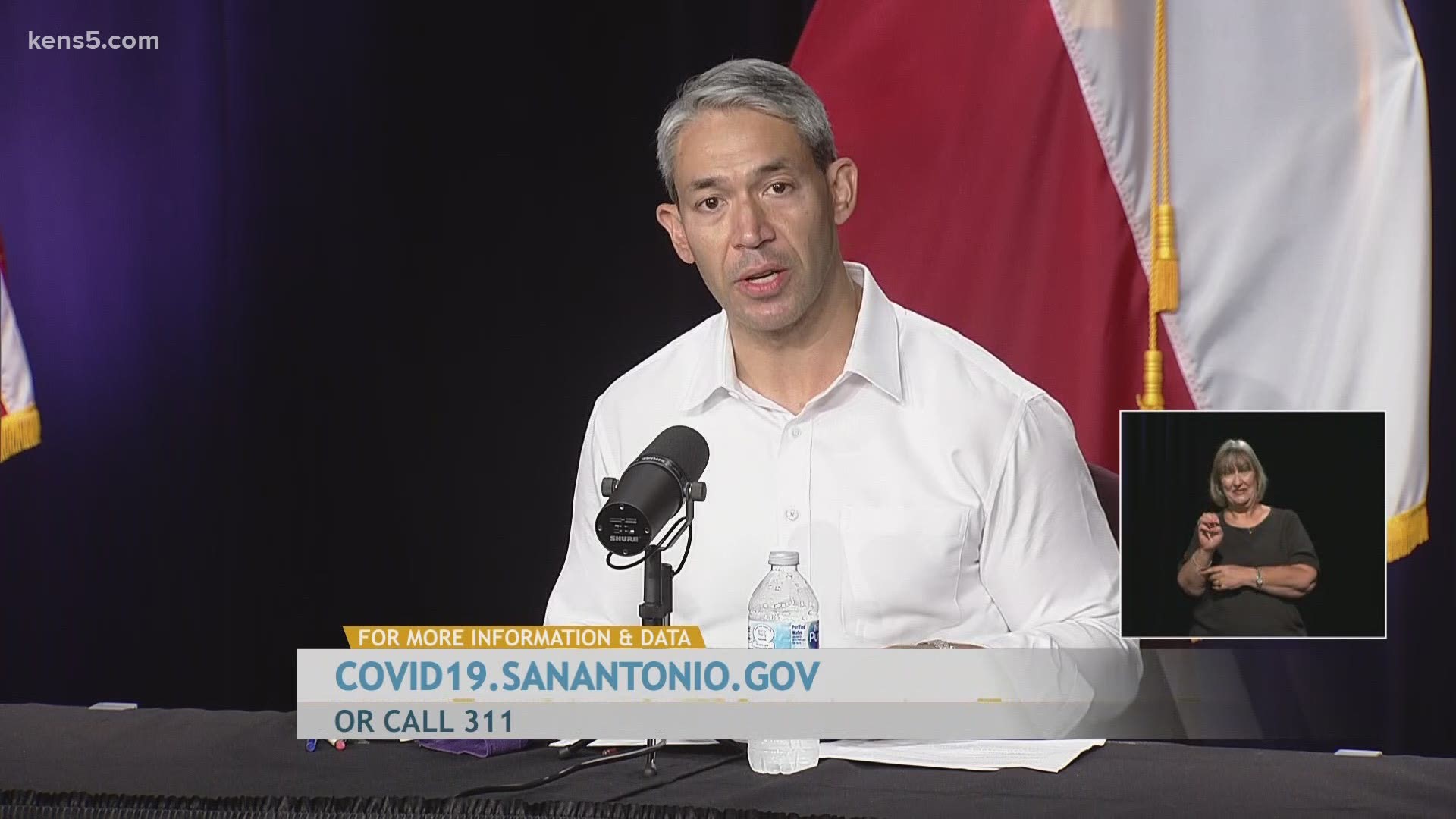SAN ANTONIO — We're tracking the latest numbers from the coronavirus pandemic in San Antonio and across Texas. Here are the latest numbers reported by Bexar and surrounding counties:
- Bexar County: 70 new cases were reported Monday, bringing the total number for the county to 44,122. The county death toll, meanwhile, rose to 617 after 19 additional fatalities were reported, some from previous days.
- Comal County: The county reported 68 new cases and no additional deaths Monday. There have been a total of 2,772 cases of COVID-19 in the county – including 2,200 confirmed cases – while 72 county residents have died. County officials say there are 513 active coronavirus cases, and 2,187 residents have recovered.
- Hays County: Officials in Hays County on Tuesday reported 42 new cases in the county since Monday. As of Tuesday evening, there were a total of 5,192 lab-confirmed cases in the county (2,563 of which are active) while the death toll remains at 41.
How Bexar County is trending
We're tracking how many coronavirus cases are confirmed in Bexar County each day from the time San Antonio Metro Health began reporting cases more than five months ago. Graphing those daily case numbers along a 14-day moving average provides an accurate picture of the curve in the San Antonio area and the direction we're heading amid the coronavirus.
On Monday, Mayor Ron Nirenberg reported an additional 70 cases of the novel coronavirus in Bexar County, bringing the total to 44,122.


The local death toll, meanwhile, rose past 600 to 617 after Metro Health confirmed an additional 19 deaths from COVID-19 complications. Some of those deaths date back as far as June 28.
Hospitalizations have trended downward for nearly a month, and that trend continued on Monday. 603 residents were receiving treatment for virus symptoms, up slightly from 612 on Sunday. The number of residents on ventilators (188) and in intensive care (267) dropped slightly from Sunday.


Hospitals are now at high stress, down from severe, with 56% of ventilators available and 18% of staffed hospital beds.
The mayor gave his weekly update on progress and warning indicators, and said that the risk level in the community is now at moderate. He said that San Antonio is doing well with testing and contact tracing capacity, and rate at which cases double is now 40 days, which is better than the target.
The positivity rate has declined as well, but Nirenberg said the current rate of 11.3% is still much higher than their target of 5%.
Coronavirus in Texas
Texas health authorities on Monday reported an additional 7,908 cases of the coronavirus from across the state, bringing the total to 542,950. State health officials clarified that 2,713 of the cases were new for the 24 hour period, and the other 5,195 cases resulted from a backlog of cases being reported to local health departments.


The death toll reached a grim new milestone, passing 10,000 cases after 51 more deaths from COVID-19 complications were reported, bringing the total to 10,034.
The number of hospitalized Texans continues to go down. On Monday, 6,200 were receiving treatment for COVID-19 symptoms.That continues nearly a month-long downward trend in the state from a peak at nearly 11,000 on July 22. This is the lowest number of patients in Texas hospitals since late June.
An estimated 405,817 Texans have recovered from the virus during the ongoing pandemic, but about 127,099 cases are active.
Latest Coronavirus Headlines
Coronavirus symptoms
The symptoms of coronavirus can be similar to the flu or a bad cold. Symptoms include fever or chills, cough, shortness of breath or difficulty breathing, fatigue, muscle or body aches, headache, new loss of taste or smell sore throat, congestion or runny nose, nausea or vomiting and diarrhea, according to the Centers for Disease Control.
Most healthy people will have mild symptoms. A study of more than 72,000 patients by the Centers for Disease Control in China showed 80 percent of the cases there were mild.
But infections can cause pneumonia, severe acute respiratory syndrome, kidney failure, and even death, according to the World Health Organization. Older people with underlying health conditions are most at risk.
On June 25, the CDC expanded the list of groups at a higher risk of severe illness due to coronavirus.
Experts determined there was consistent evidence these conditions increase a person's risk, regardless of age:
- Chronic kidney disease
- COPD (chronic obstructive pulmonary disease)
- Obesity (BMI of 30 or higher)
- Immunocompromised state (weakened immune system) from solid organ transplant
- Serious heart conditions, such as heart failure, coronary artery disease, or cardiomyopathies
- Sickle cell disease
- Type 2 diabetes
The CDC believes symptoms may appear anywhere from two to 14 days after being exposed.
Human coronaviruses are usually spread...
- Between people who are in close contact with one another (within about 6 feet).
- Through respiratory droplets produced when an infected person coughs, sneezes or talks. These droplets can land in the mouths or noses of people who are nearby or possibly be inhaled into the lungs.
- Some recent studies have suggested that COVID-19 may be spread by people who are not showing symptoms.
Help stop the spread of coronavirus
- Stay home when you are sick.
- Eat and sleep separately from your family members
- Use different utensils and dishes
- Cover your cough or sneeze with your arm, not your hand.
- If you use a tissue, throw it in the trash.

